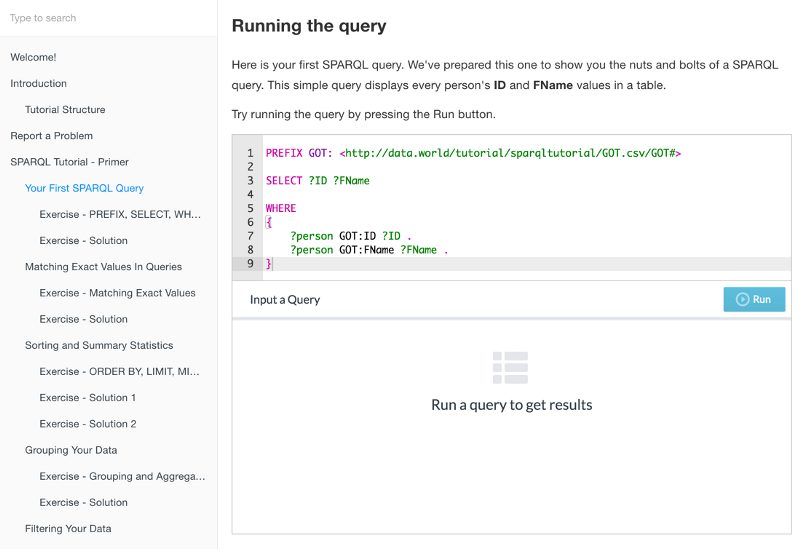







Oct 05, 2016

Shad Reynolds
VP, Engineering

tldr; Check our awesome SPARQL Tutorial!
Do you know SPARQL? No? Don’t worry, you’re not alone. As a matter of fact, there’s a pretty good possibility that you’ve never even heard of SPARQL. Let’s see what Google says…
SPARQL (pronounced “sparkle”, a recursive acronym for SPARQL Protocol and RDF Query Language) is an RDF query language, that is, a semantic query language for databases, able to retrieve and manipulate data stored in Resource Description Framework (RDF) format.
That clears things up. Right? still no?
Ok, how about this… similar to how we use SQL to query relational databases, we use SPARQL to query graph databases (sometimes referred to as a triple-stores).
But what is a graph database? Graph databases store data slightly differently than relational databases. Instead of storing data in rows and columns, graph databases store facts. Facts are represented as three values, subject, predicate, and object (sometimes referred to as subject, property, and value) which read a bit like sentences.
Peter Venkman (subject) has job (predicate) Ghostbuster (object)
Echo-1 (subject) is a (predicate) car (object)
Interestingly, any data that can be represented in a relational database can also be represented in a graph database. There are entire classes of data that can be represented in graph databases, but cannot efficiently be represented in relational databases (ex. sparse data describing webs of interconnected objects).
At data.world we use graph databases to store and enhance your data. While we’re working hard on UI features to expose knowledge so users won’t have to learn SPARQL, we also recognize that some users will want to dig deeper. To that end, we’ve put together a shiny new SPARQL tutorial.
 data.world SPARQL Tutorial
data.world SPARQL TutorialThe tutorial includes plenty of high level overviews and key concepts, but also gets you writing SPARQL quickly. No need to setup anything. Just dive right in and start executing SPARQL inline.
If you’re interested in learning more about linked data, graph databases and SPARQL, please check out the tutorial.
Also, don’t forget to join data.world to create your own queryable datasets!

tldr; Check our awesome SPARQL Tutorial!
Do you know SPARQL? No? Don’t worry, you’re not alone. As a matter of fact, there’s a pretty good possibility that you’ve never even heard of SPARQL. Let’s see what Google says…
SPARQL (pronounced “sparkle”, a recursive acronym for SPARQL Protocol and RDF Query Language) is an RDF query language, that is, a semantic query language for databases, able to retrieve and manipulate data stored in Resource Description Framework (RDF) format.
That clears things up. Right? still no?
Ok, how about this… similar to how we use SQL to query relational databases, we use SPARQL to query graph databases (sometimes referred to as a triple-stores).
But what is a graph database? Graph databases store data slightly differently than relational databases. Instead of storing data in rows and columns, graph databases store facts. Facts are represented as three values, subject, predicate, and object (sometimes referred to as subject, property, and value) which read a bit like sentences.
Peter Venkman (subject) has job (predicate) Ghostbuster (object)
Echo-1 (subject) is a (predicate) car (object)
Interestingly, any data that can be represented in a relational database can also be represented in a graph database. There are entire classes of data that can be represented in graph databases, but cannot efficiently be represented in relational databases (ex. sparse data describing webs of interconnected objects).
At data.world we use graph databases to store and enhance your data. While we’re working hard on UI features to expose knowledge so users won’t have to learn SPARQL, we also recognize that some users will want to dig deeper. To that end, we’ve put together a shiny new SPARQL tutorial.
 data.world SPARQL Tutorial
data.world SPARQL TutorialThe tutorial includes plenty of high level overviews and key concepts, but also gets you writing SPARQL quickly. No need to setup anything. Just dive right in and start executing SPARQL inline.
If you’re interested in learning more about linked data, graph databases and SPARQL, please check out the tutorial.
Also, don’t forget to join data.world to create your own queryable datasets!